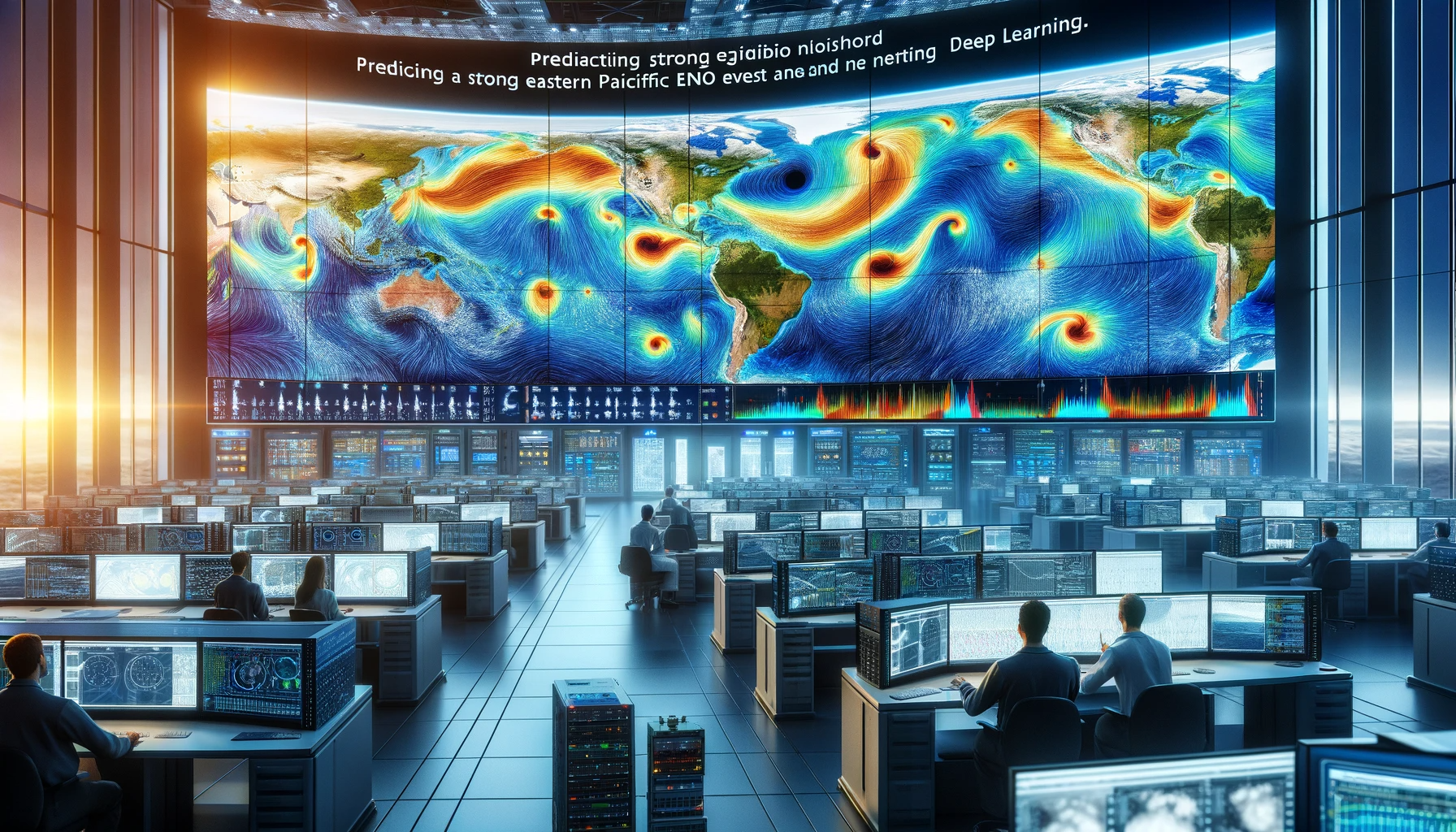In a paper published in the journal Scientific Reports, researchers tackled the intricate task of forecasting El Niño-Southern Oscillation (ENSO) diversity using a specialized deep-learning model. This model, IGP-UHM AI v1.0, focused on predicting vital eastern Pacific EN events, revealing a link between higher ENSO complexity and predictive accuracy. Their forecast, initialized in May 2023, projected a continuation of weakening EN conditions in the eastern Pacific throughout 2024, differing from historical patterns.
 Study: Using Deep Learning and XAI to Enhance El Niño-Southern Oscillation Forecast. Image credit: Generated using DALL.E.3
Study: Using Deep Learning and XAI to Enhance El Niño-Southern Oscillation Forecast. Image credit: Generated using DALL.E.3
An explainable artificial intelligence (XAI) analysis for 2023 highlighted unique precursors such as weak warm surface anomalies and disrupted winds in the western Pacific, countered by anomalies in the northern Atlantic, providing novel insights into ENSO dynamics.
Background
The ENSO drives global climate variability, with extreme EN events impacting regions like the eastern Pacific and coastal areas due to intense sea surface temperature abnormalities. Despite decent predictive skill in current models, forecasting the diversity of eastern and central Pacific events still needs to be improved, especially for substantial EN occurrences. Tuning models for robust predictions face data constraints, leading to reliance on human judgment. XAI methods offer hope by providing real-time insights into forecast variables, aiding forecasters even if AI models do not surpass traditional models.
ENSO Prediction: Leveraging IGP-UHM AI
The study leverages the IGP-UHM AI model, utilizing sea surface temperature (SST), sea surface height (SSH), zonal (U), and meridional (V) wind data from 21 Coupled Model Intercomparison Project Phase 6 (CMIP6) coupled General Circulation Models (GCMs) to predict ENSO diversity indices. Focusing on models proficient in simulating ENSO nonlinearity, they curated data for training, development, and testing. They fine-tuned the model using historical Simple Ocean Data Assimilation (SODA) from 1871 to 1984 and tested it against Global Ocean Data Assimilation System (GODAS) reanalysis from 1990 to 2022. They compared the IGP-UHM AI model against the Canadian Seasonal to the Interannual Prediction System version 2.1 (CanSIPSv2) climate forecast model.
The IGP-UHM AI model, a Convolutional Neural Network (CNN), integrates three months of SST, SSH, U, and V anomaly fields transformed for uniform variance. Employing a 3D convolutional kernel and early stopping for regularization, the model predicts E and C indices at 12-month leads and identifies vital eastern Pacific EN events in January. Hyperparameter tuning via grid search optimized the model's performance. Skill assessment involved correlation coefficients and Critical Success Index (CSI) metrics for predicting extreme EN events.
Layerwise Relevance Propagation (LRP), an XAI method, offered insights by assigning relevance scores to input variables, aiding in understanding the model's classification outputs for intense EN events. This technique highlighted spatial features impacting the model's decision-making process. The study emphasized the importance of XAI techniques in interpreting classification outputs compared to regression problems in the context of ENSO prediction.
Advancing ENSO Prediction with AI
The study focuses on developing an advanced prediction system targeting ENSO diversity, emphasizing sea surface temperature variability predictions in the eastern and central Pacific. It introduces the IGP-UHM AI deep learning model v1.0, a CNN integrated with XAI diagnostics through LRP. By incorporating observable predictors—SST, SSH, zonal, and meridional wind—the model aims for operational efficiency compared to previous studies focusing solely on SST and heat content.
The 2023–2024 Australian summer forecast, initiated with data from March–May 2023, suggests a sustained yet diminishing presence of warm EN conditions, akin to the 2015–2016 scenario but notably weaker than the impactful 1997–1998 event. However, assessing the model's predictions using LRP explanations for 2023 underscores crucial factors influencing the forecast's credibility. It points out the absence of atmospheric-ocean coupling in the equatorial Pacific, the lack of favorable northerly wind anomalies in the eastern Pacific, and the negative influence of warm anomalies in the tropical Atlantic.
The study sheds light on the IGP-UHM AI model's limitations, specifically its training on vital eastern Pacific EN events and restricted data up to 1984. It constrains its efficacy in predicting central Pacific warming events, such as the 2015–2016 episode. The model's operational adaptation will involve fine-tuning using comprehensive available data and regular updates to incorporate fresh insights from each event, which is critical for understanding ENSO diversity and climate change.
Through case studies encompassing successful predictions (1997–1998 and 2015–2016) and highlighting a false positive case, the study emphasizes the necessity for human forecasters' assessment of the model's credibility, guided by XAI diagnostics.
Ultimately, the study raises fundamental questions about the limits of ENSO predictability and the potential for current models—dynamical, statistical, or AI-based—to reach these limits. It suggests that ENSO nonlinearity constrains model skill, aligning with prior research indicating more robust ENSO variance periods are more predictable. This insight holds significance, hinting at the potential for improved predictions if greenhouse gas forcing leads to an increased frequency of robust eastern Pacific EN events, which is crucial for anticipating and managing their impacts.
Conclusion
To sum up, this study marks a significant step forward in ENSO prediction, introducing the IGP-UHM AI model v1.0, a robust system integrating deep learning and XAI for enhanced forecasting. The model's 2023–2024 forecast indicates sustained EN conditions, albeit weaker than historical impactful events.
The credibility of this forecast relies on pivotal factors identified by LRP explanations, underscoring the imperative for ongoing refinement and human oversight. The study underscores the model's limitations, highlighting the necessity for continuous adaptation and updates. Moreover, it poses fundamental questions about ENSO predictability limits and the potential for model enhancement in the face of climate change. Ultimately, this research paves the way for improved understanding and anticipation of ENSO dynamics and their broader implications.